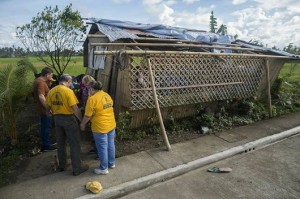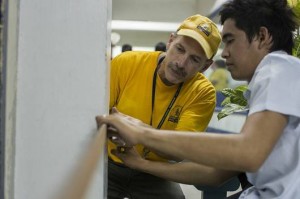CEBU CITY, Philippines (BP) — While some disaster-response organizations are pulling out of Typhoon Haiyan relief efforts in the Philippines, Southern Baptists remain on the ground, helping neglected communities rebuild homes, schools and livelihoods.
Disaster response organizations in five Southern Baptist state conventions have each adopted an area of the Philippines, said Jeff Palmer, executive director of Baptist Global Response. Seven teams of volunteers already have served, and as many as 10 more could be scheduled in the next month.

Disaster relief volunteers from the Southern Baptists of Texas Convention visited families whose homes and livelihoods were disrupted by Typhoon Haiyan. The volunteers listened to the families’ heartbreaking stories and prayed with them, then distributed badly needed food and building supplies. BGR photo.
“This is a long-term response, and the need is massive. We are initiating large-scale work with communities, local believers and volunteers and will be constantly assessing and gauging the effectiveness of our choices,” Palmer said. “Please continue to pray for families in need in the Philippines. Pray for our team members and volunteers as they help in the face of overwhelming needs. Pray that we choose the most strategic and effective places to work that truly help people physically and spiritually.”
Southern Baptists have donated about $1.3 million for the relief effort through the International Mission Board and BGR. The main priorities in the work are repair and construction of houses and schools, along with water systems.
IMB has arranged for a volunteer coordinator to be assigned to the recovery. When that person begins work in mid- to late-February, the number of volunteers from the United States involved in the effort can be greatly expanded, Palmer said.
The task ahead is enormous, said a BGR partner who recently flew into Tacloban, a city of 220,000 that took the brunt of Haiyan’s 195-mph winds on Nov. 7.
“BGR is gearing up for long-term development work as the short-term relief organizations pull out,” said the partner, who could not be named for security reasons. “There is much work to do as we survey areas farther from town that have been neglected but desperately need help as they try to rebuild their lives.”

Mike Phillips of Bellville, Texas, works alongside residents on Panay Island in the Philippines as they repair a school badly damaged by Typhoon Haiyan. Disaster response volunteers from five Baptist state conventions have each adopted an area of the Philippines for recovery work. Seven teams of volunteers already have served, and as many as 10 more could be scheduled in the coming weeks. BGR photo.
More than two months after the storm, BGR partners reported Tacloban is returning to life, but there are still many visible signs of damage. They spotted ocean-going ships grounded on shore and thick electrical posts snapped by the wind and storm surge. “One restaurant owner told us the typhoon and flooding was bad, but even worse was the damage done by looters right after the storm,” the partner said. The airport still does not have a control tower.
“As our plane approached Tacloban, it was raining and windy,” the partner said. “Without a control tower, the pilot had some unique challenges, especially when he discovered there was a stalled vehicle on the runway! We circled for a second try at landing and made it.”
A base of operations for the recovery effort has been established in Cebu City, Palmer said, from which five areas of work are being coordinated. Missouri Baptist Convention volunteers are working on Gibitngil Island; the Southern Baptists of Texas Convention is focused on Panay Island; California Southern Baptist Convention teams will work in Ormoc; Tennessee Baptists are preparing to work on northern Cebu Island; and Kansas-Nebraska Southern Baptists are planning to set up an operations base in Tacloban.
In the fishing community of Agojo on northern Panay Island, a full 75 percent of the homes were damaged or destroyed in the storm, said Ben Wolf, who with his wife Pam directs BGR work in Asia Rim.
“Approximately 40 families have been identified as needing assistance and are currently being evaluated for priority,” Wolf said. “Some temporary shelters need to be erected immediately, and a priority classroom area has been identified for repair at the local elementary school, which was badly damaged in the storm. Sanitation is lacking, so building community latrines also may be possible.”
The BGR relief effort in Agojo, as in other areas, will help families by providing short-term work, as well as repairing homes and schools, Wolf added. “The community has a labor force needing work, and capable, skilled men will be contracted to work alongside [a] U.S. disaster response team and local volunteer labor when available.”

In the aftermath of Typhoon Haiyan, the greatest need in most Filipino communities is for shelter. Southern Baptists have donated about $1.3 million for the relief effort through the International Mission Board and Baptist Global Response. A housing kit has been designed that will put up a small, wood-framed shelter on stilts for about $250. BGR photo.
To help with home reconstruction, BGR has designed a housing kit that will put up a small, wood-framed shelter on stilts for about $250, Palmer said. In some locations, construction will be done with local bamboo or local lumber.
On Gibitngil Island, bags of cement have been shipped from Cebu, and concrete blocks are being manufactured on site to replace a school building that was completely destroyed. A three-room school building has been re-roofed, and the school’s water retention system has been restored and expanded. Volunteers from California and Louisiana have helped with that effort. The California volunteers repaired a downed flagpole, and the entire community celebrated with a flag-raising ceremony.
Palmer voiced gratitude “to all those who have helped in this response, both those who have worked so hard in the Philippines and those who continue to give generously to make this effort possible.” He also lauded “the teamwork of those involved and the patience of those wanting to get involved.”
“While no response is perfect, we are in a good place to maximize our impact in the Philippines,” Palmer said.
Mark Kelly writes for Baptist Global Response. To become involved in post-typhoon recovery in the Philippines, go to “Funding Human Needs” to connect to IMB’s General Relief Fund.






